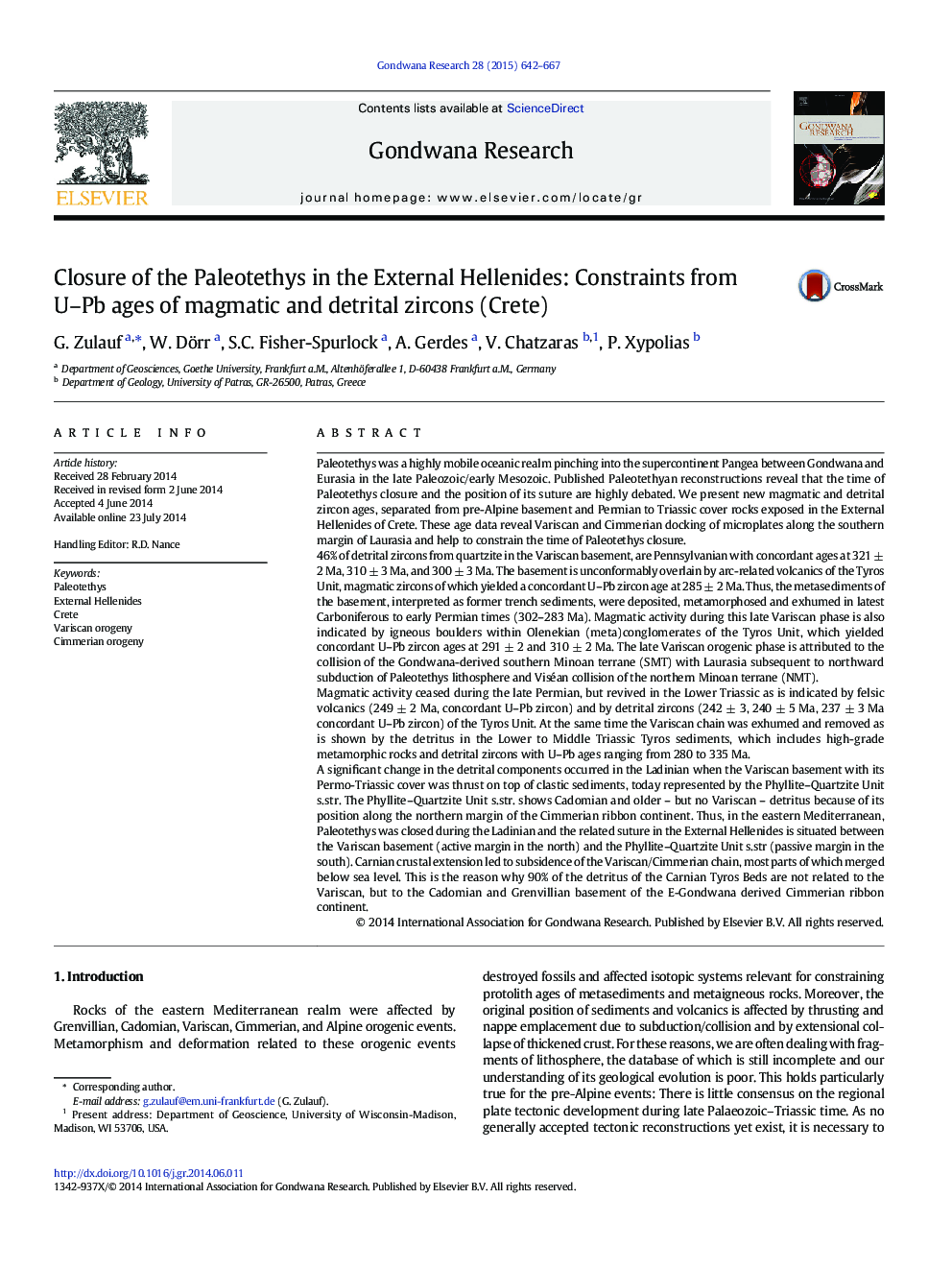| کد مقاله | کد نشریه | سال انتشار | مقاله انگلیسی | نسخه تمام متن |
|---|---|---|---|---|
| 4726881 | 1356350 | 2015 | 26 صفحه PDF | دانلود رایگان |

• Paleotethys closure in the External Hellenides occurred in the Ladinian.
• Paleotethys suture is situated between basement and Phyllite–Quartzite Unit s.str.
• The ages of detrital zircons of the Tyros Unit change significantly in the Ladinian.
Paleotethys was a highly mobile oceanic realm pinching into the supercontinent Pangea between Gondwana and Eurasia in the late Paleozoic/early Mesozoic. Published Paleotethyan reconstructions reveal that the time of Paleotethys closure and the position of its suture are highly debated. We present new magmatic and detrital zircon ages, separated from pre-Alpine basement and Permian to Triassic cover rocks exposed in the External Hellenides of Crete. These age data reveal Variscan and Cimmerian docking of microplates along the southern margin of Laurasia and help to constrain the time of Paleotethys closure.46% of detrital zircons from quartzite in the Variscan basement, are Pennsylvanian with concordant ages at 321 ± 2 Ma, 310 ± 3 Ma, and 300 ± 3 Ma. The basement is unconformably overlain by arc-related volcanics of the Tyros Unit, magmatic zircons of which yielded a concordant U–Pb zircon age at 285 ± 2 Ma. Thus, the metasediments of the basement, interpreted as former trench sediments, were deposited, metamorphosed and exhumed in latest Carboniferous to early Permian times (302–283 Ma). Magmatic activity during this late Variscan phase is also indicated by igneous boulders within Olenekian (meta)conglomerates of the Tyros Unit, which yielded concordant U–Pb zircon ages at 291 ± 2 and 310 ± 2 Ma. The late Variscan orogenic phase is attributed to the collision of the Gondwana-derived southern Minoan terrane (SMT) with Laurasia subsequent to northward subduction of Paleotethys lithosphere and Viséan collision of the northern Minoan terrane (NMT).Magmatic activity ceased during the late Permian, but revived in the Lower Triassic as is indicated by felsic volcanics (249 ± 2 Ma, concordant U–Pb zircon) and by detrital zircons (242 ± 3, 240 ± 5 Ma, 237 ± 3 Ma concordant U–Pb zircon) of the Tyros Unit. At the same time the Variscan chain was exhumed and removed as is shown by the detritus in the Lower to Middle Triassic Tyros sediments, which includes high-grade metamorphic rocks and detrital zircons with U–Pb ages ranging from 280 to 335 Ma.A significant change in the detrital components occurred in the Ladinian when the Variscan basement with its Permo-Triassic cover was thrust on top of clastic sediments, today represented by the Phyllite–Quartzite Unit s.str. The Phyllite–Quartzite Unit s.str. shows Cadomian and older – but no Variscan – detritus because of its position along the northern margin of the Cimmerian ribbon continent. Thus, in the eastern Mediterranean, Paleotethys was closed during the Ladinian and the related suture in the External Hellenides is situated between the Variscan basement (active margin in the north) and the Phyllite–Quartzite Unit s.str (passive margin in the south). Carnian crustal extension led to subsidence of the Variscan/Cimmerian chain, most parts of which merged below sea level. This is the reason why 90% of the detritus of the Carnian Tyros Beds are not related to the Variscan, but to the Cadomian and Grenvillian basement of the E-Gondwana derived Cimmerian ribbon continent.
Figure optionsDownload as PowerPoint slide
Journal: Gondwana Research - Volume 28, Issue 2, September 2015, Pages 642–667